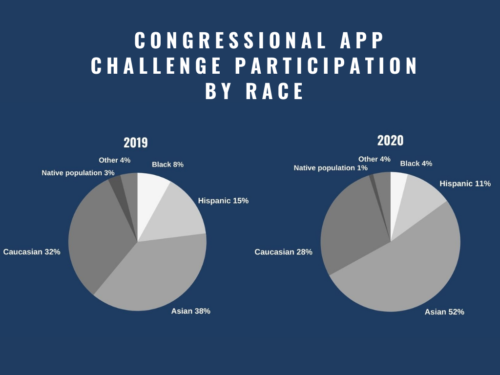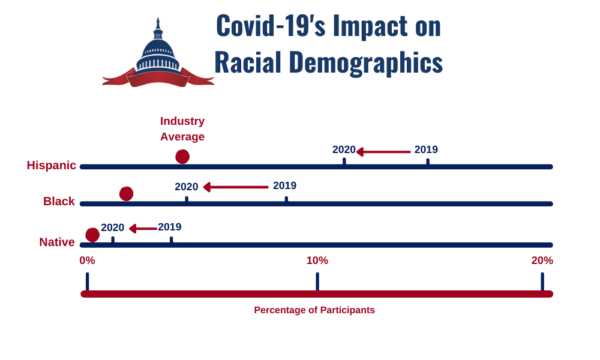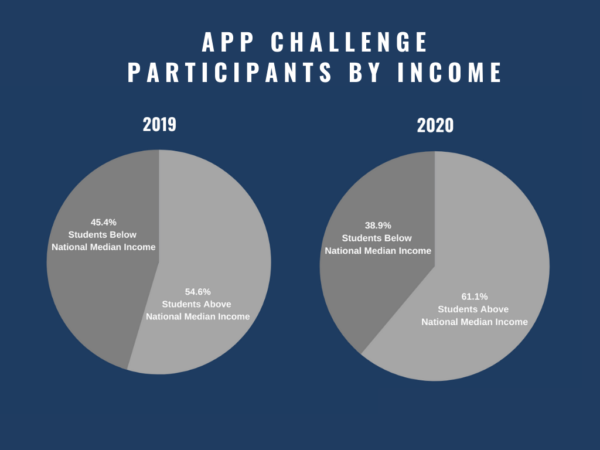COVID’s impact on diversity is a new puzzle for STEM to solve
After a year marked by educational disruptions, the Congressional App Challenge looks to:
- Analyze inequalities in tech to understand the role the pandemic played in amplifying them
- Expand underserved student participation in STEM
- Make key investments to keep students competitive in the future American workforce
It is difficult to quantify the effects that the COVID-19 pandemic has had on STEM education in 2020, however we know for certain that it played a significant role in exacerbating racial and educational inequalities in tech that existed before the pandemic. Emerging evidence has shown that the pandemic widened pre-existing disparities in computer science and STEM subjects by creating barriers to education, such as a lack of access to tech hardware, lack of a stable environment for online learning, and lack of educational support, all of which made it harder to stay engaged and complete assignments in virtual classrooms. These barriers to education highlight how fragile the infrastructure for STEM and computer science education is when a global crisis such as a pandemic comes along. We need to invest in technology and programs that support tech in a way that makes STEM education sustainable and accessible to all students across the nation.
“Underserved communities are disproportionately impacted by the educational gap caused by COVID-19″

According to the Office of Civil Rights Department of Education, “we can see already that many of [the] impacts [of the pandemic] are falling disproportionately on students who went into the pandemic with the greatest educational needs and fewest opportunities—many of them from historically marginalized and underserved groups.” In 2020, there was 4% participation from Black students, 11% from Hispanic students, 52% from Asian students, 28% from Caucasian students, 1% from Indigenous students, and 4% participation from students that identify with a different racial demographic group. From 2020 to 2019, we see a combined drop greater than 10% in App Challenge participation from Black students, Hispanic students, and Indigenous students. Participation from Caucasian and Asian students in the CAC either stayed relatively the same or increased. This data matches trends from the New York Times regarding student engagement in STEM during the pandemic.
“We can see already that many of [the] impacts [of the pandemic] are falling disproportionately on students who went into the pandemic with the greatest educational needs and fewest opportunities—many of them from historically marginalized and underserved groups.”

Another major consequence of the pandemic that faces STEM infrastructure is a lack of representation from different socioeconomic groups. A study on the digital inequalities perpetuated by COVID-19 showed that low income households are less equipped with technological devices in quality and quantity and therefore suffer from the direct and long term consequences of the COVID-19 pandemic more severely (Beaunoyer et al.) When we compare pre-pandemic App Challenge participation to participation in 2020, we see similar outcomes reflected in our data. Between 2020 and 2019, there was a 20% decrease in App Challenge participation by students living below the national median income. Furthermore, there was a 22% decrease in participation from students living within 2x of the poverty line, and a 75% decrease in participation from students living below the poverty line. Increasing equity in STEM education is essential to leveling the playing field and allowing for growth that not only affects the tech industry, but spills over to other areas of the American economy.
“Low income households are less equipped with technological devices in quality and quantity and therefore suffer from the direct and long term consequences of the COVID-19 pandemic more severely.”

The Congressional App Challenge is one of the most prestigious competitions in student computer science in America, and while we strive to break down barriers that prevent equal representation of competitors, we are limited in both funding and staffing. We offer as much support to as many Congressional offices as we can, however much of the outreach for student recruitment must come from each district. In particular, educators are essential to helping students navigate the world of STEM and inspire a diverse and robust pipeline of STEM talent. Students have reported that engaging in STEM virtually is difficult because they are forced to learn independently rather than in a way that is hands-on and collaborative. This is especially true in the context of the App Challenge. In 2019, 65% of student recruitment came from teachers introducing the competition in their classrooms and supporting students through the app development process. Without in-person instruction, teacher-led student recruitment fell to 43% in 2020.
“In 2019, 65% of student recruitment came from teachers introducing the competition in their classrooms and supporting students through the app development process. Without in-person instruction, teacher-led student recruitment fell to 43% in 2020.”
“Investing in programs like the Congressional App Challenge is essential to tackling the issue of under-representation in technology, and to overcome the structural issues in education that were intensified by the pandemic.”
Empowering students with an interest in STEM is vital for innovation and sustainable growth for the future. In just one year without funding and support during the pandemic, we saw a huge drop off in STEM education. Allocating funding from the Infrastructure Bill to computer science education, adopting new practices and investing in programs like the Congressional App Challenge is essential to tackling the issue of underrepresentation in technology, and to overcome the structural issues in education that were intensified by the pandemic.
